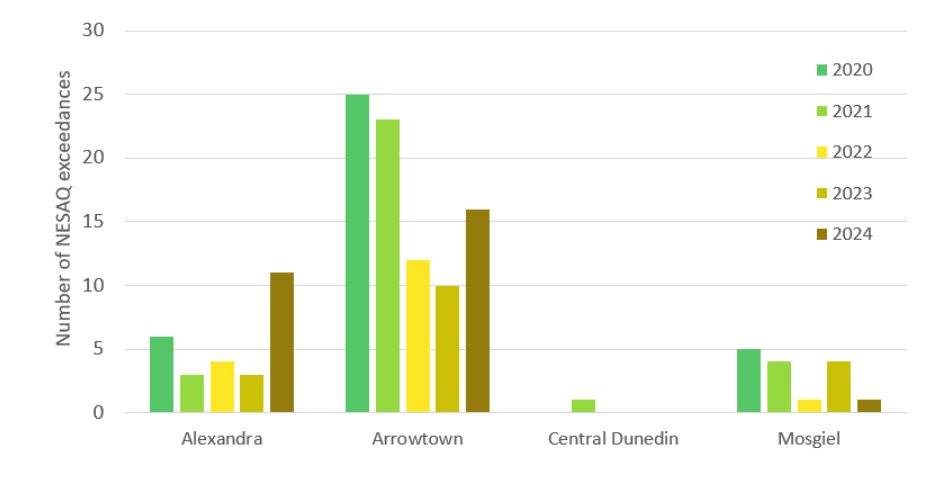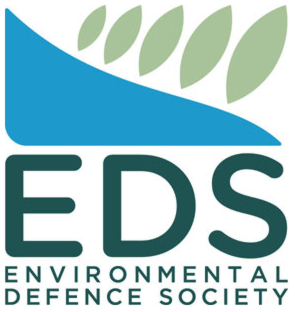Air Quality Monitoring Expands As Seasonal Challenges Continue
Otago Regional Council has released its Annual Air Quality Report for 2024, revealing some challenges in managing air quality across the region.
The report underscores the importance of ongoing community engagement, updated monitoring technologies, and a clear path forward as part of Otago’s commitment to cleaner air and healthier communities, says ORC’s Air Quality Scientist, Sarah Harrison.
The annual report shows that while some areas still face winter air quality exceedances —particularly Alexandra, Arrowtown and Mosgiel — over 70% of days across monitored sites were classified as “Good” under the Ministry for the Environment’s Environmental Performance Indicators.
The report includes PM2.5 monitoring (particulate matter with a diameter of less than 2.5 micrometres) data at seven locations. These fine air particulates (PM2.5) pose greater health risks to communities.
A new PM2.5 monitoring site was installed in Frankton in late 2024 and this data will be reported in the next annual report.
Black carbon is a component of PM and monitoring of it will help improve both our understanding of PM as a product of burning, and black carbon as a health and climate pollutant.
“Monitoring smaller sizes of particulate matter (PM2.5) is a significant step forward,” Ms Harrison says.
“These smaller particles pose greater health risks, and by enhancing our network, we’re better equipped to inform policy and protect community wellbeing.”
While winter emissions continue to be a challenge, especially in towns where home heating is the main source of particulate matter, the seasonal patterns reinforce the importance of community focused initiatives like Burn Dry, Breathe Easy, which encourage the use of cleaner heating methods.
“We’re not just measuring air quality — we’re continuing to build the evidence needed to inform decisions and we’re also building stronger community partnerships,” Ms Harrison added.
“Improving air quality in Otago is a shared responsibility, and the data tells us we’re on the right track, even if there’s more work to do.”
Upgrades to the air quality monitoring network will continue throughout 2025, including more co-location and calibration work to improve the accuracy of new instruments. These investments ensure the ORC remains at the forefront of air quality management, backed by reliable science and community collaboration.

Upon validating last year’s winter data, Otago recorded *28 exceedances of the NESAQ (National Environmental Standards for Air Quality) for PM10 during the winter months in 2024, compared with 17 exceedances in winter 2023.
Otago has several towns where air quality is considered degraded during winter, namely Alexandra, Arrowtown, Clyde, Cromwell, Milton, and Mosgiel.
In Otago, the main source of PM is home heating emissions in winter. Long term exposure to PM2.5 and PM10 contribute to the risks of cardiovascular and respiratory conditions.
Mobile air quality trailer – maiden mission
A mobile air quality monitoring station was acquired by ORC last year to monitor PM2.5. PM2.5 is a pollutant emitted by combustion.
In Otago, a lot of PM2.5 comes from burning wood for home heating and is seen in the data for most towns. PM data is extremely seasonal with very high concentrations in winter.
Having a mobile air quality monitoring station will allow ORC’s science team to:
· Collect air quality data across a number of locations in Otago
· Investigate pollution hotspots, industrial zones, or areas with complaints
· Gather time-sensitive data during specific events or seasons
· Help raise awareness by visibly showing communities their local air quality
· Teach about pollution and environmental health at schools or public demonstrations.
· Monitor multiple communities or research sites
· Quickly deploy a monitoring station in response to environmental events, accidents, or wildfires.
The air quality trailer’s first assignment is to learn more about the concentration patterns in the Wānaka area. It is currently installed in the reserve on Rifleman Street in Albert Town. ORC also has a monitoring site in Wānaka township.
The information gathered at these two locations will be useful in understanding where the highest concentrations occur. Concentrations can vary due to density of housing, types of emissions, topography, how sheltered an area is, and wind speed and direction.
The PM2.5 sensor is the small box located halfway up the mast. The meteorological sensor is at the end of the mast. This measures temperature, humidity, wind speed and direction, and atmospheric pressure — all of these help us to analyse the PM2.5 data.
The data is being collected but the real-time transfer of data from the mobile monitoring station to LAWA is still being set up.
 |  |
New Frankton monitoring station
ORC monitors Otago’s air quality at air monitoring stations, located in towns across the region.
The stations measure the amount of combustion-related particles in the air (think particles from wood burning, vehicles, and industrial operations as examples).
This latest addition to our region-wide monitoring network is a permanent monitoring station, recently installed in the Kawarau Falls Playground in Frankton to monitor PM2.5 in the area. These are particles from combustion alone.
To learn more about particulate matter (PM) and find out the air quality in your area, go to www.lawa.org.nz/explore-data/otago-region/air-quality
Data from this new station in Frankton will make its way onto LAWA in coming months.
Burn Dry, Breathe Easy firewood campaign
Given the predominance of home heating emissions seen in our air quality data, ORC runs an annual Burn Dry, Breathe Easy campaign.
The campaign highlights better ways to manage home heating emissions, including checking wood is dry before burning and not burning wet wood or rubbish — both of which have an adverse effect on air quality and the environment.
Woodsmoke pollution can be reduced when residents burn only dry wood and keep their fire hot and not smouldering. Further woodsmoke reductions could potentially be made through thermally efficient homes with good insulation, she says.
Burn Dry, Breathe Easy tips:
- Stack your firewood off the ground and out of the rain — anywhere you wouldn’t put your washing out to dry
- Use a wood moisture meter to check if your firewood is dry enough to burn. Less than 25% moisture means more heat and reduced smoke
- A well-built fire of scrunched up paper or firelighters, dry kindling and firewood ensures a well-heated home and less smoke
- Don’t burn wet or green firewood, treated wood or household rubbish as they can release harmful toxins into the air
- To reduce smoke overnight, make sure you can still see flames when you turn your fire down
- Plan ahead — stock up on firewood before Christmas to allow it to dry out before the following winter.
Everyone has responsibilities whether at home or as landowners, industry, or businesses to play their part to improving air quality.
The Council hopes the campaign encourages people to think about the health of their families and community and use wood burners responsibly or consider the installation of ultra-low emission burners or heat pumps.
Notes:
*ORC issued a media release last October on an increase in winter air quality exceedances (linked below). And while there was an increase in recorded exceedances in 2024 compared to 2023, figures quoted have now been confirmed as raw data from monitoring equipment and had not yet been validated.
This data has since been validated and shows Arrowtown experienced only 16 exceedances and not 25. Therefore, there were only 28 winter air quality exceedances for Otago in 2024 and not 37.


 Gordon Campbell: On Wealth Taxes And Capital Flight
Gordon Campbell: On Wealth Taxes And Capital Flight Department of Conservation: DOC Reveals Surprising Toilet Paper Stats
Department of Conservation: DOC Reveals Surprising Toilet Paper Stats NZ Government: Consultation Opens On Sweeping Overhaul Of Primary Sector Regulations
NZ Government: Consultation Opens On Sweeping Overhaul Of Primary Sector Regulations Manaaki Whenua Landcare Research: How Have Our Garden Birds Been Tracking Since 2014?
Manaaki Whenua Landcare Research: How Have Our Garden Birds Been Tracking Since 2014? NZ Labour Party: Govt Driving Away Kiwi Innovators And Scientists
NZ Labour Party: Govt Driving Away Kiwi Innovators And Scientists PSA: Govt Funding Squeeze Sees DOC Propose Cutting 84 Roles
PSA: Govt Funding Squeeze Sees DOC Propose Cutting 84 Roles NZ Police: Police Statement On Retail Crime
NZ Police: Police Statement On Retail Crime


